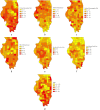Construction and case study of a novel lung cancer risk index
- PMID: 36474178
- PMCID: PMC9724373
- DOI: 10.1186/s12885-022-10370-4
Construction and case study of a novel lung cancer risk index
Abstract
Purpose: This study constructs a lung cancer risk index (LCRI) that incorporates many modifiable risk factors using an easily reproducible and adaptable method that relies on publicly available data.
Methods: We used meta-analysis followed by Analytic Hierarchy Process (AHP) to generate a lung cancer risk index (LCRI) that incorporates seven modifiable risk factors (active smoking, indoor air pollution, occupational exposure, alcohol consumption, secondhand smoke exposure, outdoor air pollution, and radon exposure) for lung cancer. Using county-level population data, we then performed a case study in which we tailored the LCRI for use in the state of Illinois (LCRIIL).
Results: For both the LCRI and the LCRIIL, active smoking had the highest weights (46.1% and 70%, respectively), whereas radon had the lowest weights (3.0% and 5.7%, respectively). The weights for alcohol consumption were 7.8% and 14.7% for the LCRI and the LCRIIL, respectively, and were 3.8% and 0.95% for outdoor air pollution. Three variables were only included in the LCRI: indoor air pollution (18.5%), occupational exposure (13.2%), and secondhand smoke exposure (7.6%). The Consistency Ratio (CR) was well below the 0.1 cut point. The LCRIIL was moderate though significantly correlated with age-adjusted lung cancer incidence (r = 0.449, P < 0.05) and mortality rates (r = 0.495, P < 0.05).
Conclusion: This study presents an index that incorporates multiple modifiable risk factors for lung cancer into one composite score. Since the LCRI allows data comprising the composite score to vary based on the location of interest, this measurement tool can be used for any geographic location where population-based data for individual risk factors exist. Researchers, policymakers, and public health professionals may utilize this framework to determine areas that are most in need of lung cancer-related interventions and resources.
Keywords: Analytic hierarchy processes; Lung cancer; Meta-analysis; Risk factors; Risk index.
© 2022. The Author(s).
Conflict of interest statement
The authors have no conflicts of interest to disclose.
Figures



Similar articles
-
An epidemiological study of risk factors for lung cancer in Guangzhou, China.Lung Cancer. 1996 Mar;14 Suppl 1:S9-37. doi: 10.1016/s0169-5002(96)90208-1. Lung Cancer. 1996. PMID: 8785671
-
Effects of long-term exposure to traffic-related air pollution on respiratory and cardiovascular mortality in the Netherlands: the NLCS-AIR study.Res Rep Health Eff Inst. 2009 Mar;(139):5-71; discussion 73-89. Res Rep Health Eff Inst. 2009. PMID: 19554969
-
Indoor radon exposure and risk of lung cancer: a nested case-control study in Finland.J Natl Cancer Inst. 1996 Jul 17;88(14):966-72. doi: 10.1093/jnci/88.14.966. J Natl Cancer Inst. 1996. PMID: 8667427
-
Diet as a confounder of the association between air pollution and female lung cancer: Hong Kong studies on exposures to environmental tobacco smoke, incense, and cooking fumes as examples.Lung Cancer. 1996 Mar;14 Suppl 1:S47-61. doi: 10.1016/s0169-5002(96)90210-x. Lung Cancer. 1996. PMID: 8785667 Review.
-
An overview of the North American residential radon and lung cancer case-control studies.J Toxicol Environ Health A. 2006 Apr;69(7):599-631. doi: 10.1080/15287390500260960. J Toxicol Environ Health A. 2006. PMID: 16608829 Review.
References
-
- American Cancer Society.; https://www.cancer.org/. [Cited 20 Apr 2021]. Available from
-
- Malhotra J, et al. (2016) Risk factors for lung cancer worldwide. Eur Respir J. 2016;48(3):889–902. - PubMed
-
- Wang Q, Gümüş ZH, Colarossi C, Memeo L, Wang X, Kong CY, Boffetta P. Small Cell Lung Cancer: Epidemiology, Risk Factors, Genetic Susceptibility, Molecular Pathology, Screening and Early Detection. Journal of thoracic oncology : official publication of the International Association for the Study of Lung Cancer. 2022;S1556–0864(22)01851–2. Advance online publication. - PMC - PubMed
Publication types
MeSH terms
LinkOut - more resources
Full Text Sources
Medical

